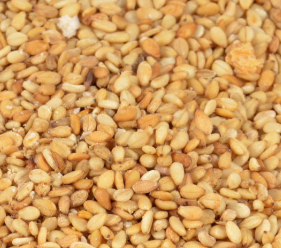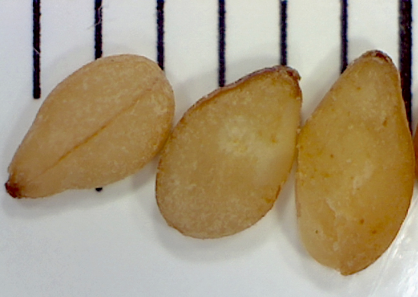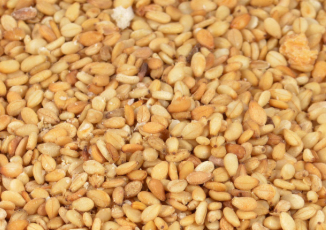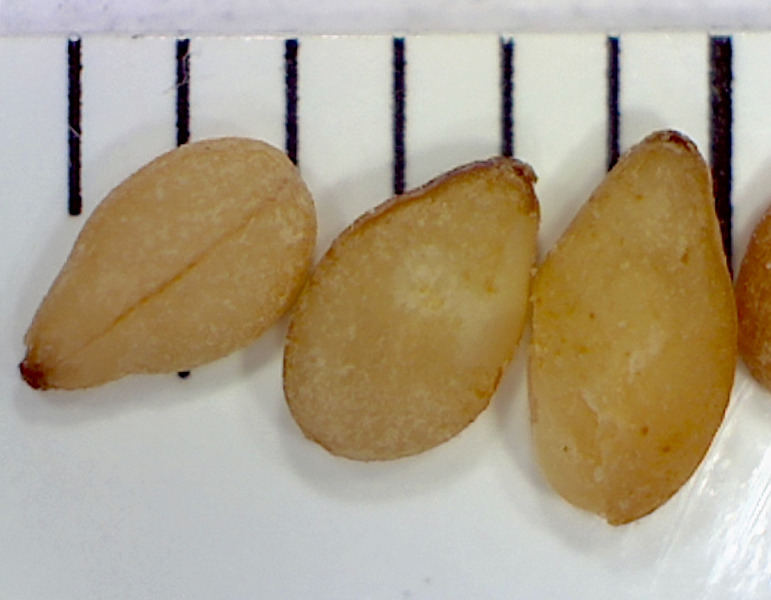![]() Sesamum indicum seed oil
Sesamum indicum seed oil
Rating : 7
| Evaluation | N. Experts | Evaluation | N. Experts |
|---|---|---|---|
| 1 | 6 | ||
| 2 | 7 | ||
| 3 | 8 | ||
| 4 | 9 | ||
| 5 | 10 |
Pros:
Antioxidant (1) Oral hygiene. Anti-plaque (1)9 pts from Ottika11
| Sign up to vote this object, vote his reviews and to contribute to Tiiips.Evaluate | Where is this found? |
| "Sesamum indicum seed oil studies" about Sesamum indicum seed oil Review Consensus 10 by Ottika11 (2062 pt) | 2022-Oct-19 11:10 |
| Read the full Tiiip | (Send your comment) |
Compendium of the most significant studies with reference to properties, intake, effects.
Johnson W Jr, Bergfeld WF, Belsito DV, Hill RA, Klaassen CD, Liebler DC, Marks JG Jr, Shank RC, Slaga TJ, Snyder PW, Andersen FA. Amended safety assessment of Sesamum indicum (sesame) seed oil, hydrogenated sesame seed oil, Sesamum indicum (sesame) oil unsaponifiables, and sodium sesameseedate. Int J Toxicol. 2011 May;30(3 Suppl):40S-53S. doi: 10.1177/1091581811406987.
Abstract. Sesamum indicum (sesame) seed oil and related cosmetic ingredients are derived from Sesamum indicum. Sesamum indicum (sesame) seed oil, sesamum indicum (sesame) oil unsaponifiables, and hydrogenated sesame seed oil function as conditioning agents. Sodium sesameseedate functions as a cleansing agent, emulsifying agent, and a nonaqueous viscosity increasing agent. These ingredients are neither skin irritants, sensitizers, teratogens, nor carcinogens at exposures that would result from cosmetic use. Both animal and human data relevant to the cosmetic use of these ingredients were reviewed. The CIR Expert Panel concluded that these ingredients are safe in the present practices of use and concentration as described in this safety assessment.
Li C, Miao H, Wei L, Zhang T, Han X, Zhang H. Association mapping of seed oil and protein content in Sesamum indicum L. using SSR markers. PLoS One. 2014 Aug 25;9(8):e105757. doi: 10.1371/journal.pone.0105757.
Abstract. Sesame is an important oil crop for the high oil content and quality. The seed oil and protein contents are two important traits in sesame. To identify the molecular markers associated with the seed oil and protein contents in sesame, we systematically performed the association mapping among 369 worldwide germplasm accessions under 5 environments using 112 polymorphic SSR markers. The general linear model (GLM) was applied with the criteria of logP ≥ 3.0 and high stability under all 5 environments. Among the 369 sesame accessions, the oil content ranged from 27.89%-58.73% and the protein content ranged from 16.72%-27.79%. A significant negative correlation of the oil content with the protein content was found in the population. A total of 19 markers for oil content were detected with a R2 value range from 4% to 29%; 24 markers for protein content were detected with a R2 value range from 3% to 29%, of which 19 markers were associated with both traits. Moreover, partial markers were confirmed using mixed linear model (MLM) method, which suggested that the oil and protein contents are controlled mostly by major genes. Allele effect analysis showed that the allele associated with high oil content was always associated with low protein content, and vice versa. Of the 19 markers associated with oil content, 17 presented near the locations of the plant lipid pathway genes and 2 were located just next to a fatty acid elongation gene and a gene encoding Stearoyl-ACP Desaturase, respectively. The findings provided a valuable foundation for oil synthesis gene identification and molecular marker assistant selection (MAS) breeding in sesame.

Asokan S, Emmadi P, Chamundeswari R. Effect of oil pulling on plaque induced gingivitis: a randomized, controlled, triple-blind study. Indian J Dent Res. 2009 Jan-Mar;20(1):47-51. doi: 10.4103/0970-9290.49067.
Abstract. Background: Oil pulling has been used extensively as a traditional Indian folk remedy for many years for strengthening teeth, gums, and the jaw and to prevent decay, oral malodor, bleeding gums, dryness of the throat, and cracked lips. Aims: The aim of this study was to evaluate the effect of oil pulling with sesame oil on plaque-induced gingivitis and to compare its efficacy with chlorhexidine mouthwash....Results: There was a statistically significant reduction of the pre- and post-values of the plaque and modified gingival index scores in both the study and control groups (P < 0.001 in both). There was a considerable reduction in the total colony count of aerobic microorganisms present in both the groups. Conclusion: The oil pulling therapy showed a reduction in the plaque index, modified gingival scores, and total colony count of aerobic microorganisms in the plaque of adolescents with plaque-induced gingivitis.
Jannat B, Oveisi MR, Sadeghi N, Hajimahmoodi M, Behzad M, Nahavandi B, Tehrani S, Sadeghi F, Oveisi M. Effect of Roasting Process on Total Phenolic Compounds and γ-tocopherol Contents of Iranian Sesame Seeds (Sesamum indicum). Iran J Pharm Res. 2013 Fall;12(4):751-8.
Abstract. Sesame (Sesamum indicum L.) seed and oil have long been used widely as healthy foods to supply energy and prevent aging. Some of the main active anti-oxidative constituents in sesame seeds are γ-tocopherol and phenols. The purpose of this study was to investigate the relationship between roasting temperature and time with γ-tocopherol and total phenolic compounds (TPC) of sesame seeds when roasted in a domestic electric oven. Eight cultivars of sesame seeds in this study were Darab, Dezful, Karaj, Moghan, Naz- Branching, Naz-NonBranching, Siah and Varamin. Each cultivar was divided into ten group based on the roasting time (10, 15 and 20 min) and temperatures (180, 200 and 220 °C)andunroasted one. The high-performance liquid chromatography (HPLC) and spectrophotometeric methods were used for γ-tocopherol (n = 80) and TPC (n = 80) analysis, respectively. The γ-tocopherol content ranged from 329 ± 5 mg/L in Naz-Branching sesame oil to 1114±7 mg/L in Siah sesame oil and 169±6 to 577±1 mg/kg in sesame seed respectively. γ-tocopherol content of six cultivars increased significantly (p < 0.05) as the roasting temperature and time; until 200 °C for 10 min, but they were decreased by roasting at 220 °C in longer time. Also TPC increased significantly as the roasting temperature. The amount of TPC varied in different sesame cultivars from 20.109 ± 3.967 μM to 129.300±3.493 in Varamin and Naz- Branching sesame seed cultivars, respectively, also TPC increased from 70.953 ± 5.863 μM in unroasted Naz-Branching sesame seed to 129.300 ± 3.493 μM after roasting in 200 °C for 20 min. The present study showed that Iranian sesame seed can be considered as a good source of natural antioxidant specially after roasting. The optimum temperature and time roasting to obtain the most γ-tocopherol and total phenolic content was 200 °C for 10 and 20 min, respectively.
Warra, A. A. (2011). Sesame (sesamum indicum l.) seed oil methods of extraction and its prospects in cosmetic industry: a review. Bayero Journal of Pure and Applied Sciences, 4(2), 164-168.
Abstract. The relative abundance of sesame seed oil coupled with the little knowledge of its cosmetic usage prompted the need for this review. The aim is to discuss the various extraction methods of the sesame seed oil and its industrial applications particularly its application in cosmetic production. The review focused mainly on the traditional African methods of extraction and the utilization of the seed oil in soap making and production of skin moisturizers.
Carvalho, R. H. R., Galvão, E. L., Barros, J. A. C., Conceição, M. M., & Sousa, E. M. B. D. (2012). Extraction, fatty acid profile and antioxidant activity of sesame extract (Sesamum Indicum L.). Brazilian Journal of Chemical Engineering, 29, 409-420.
Abstract. This article carried out the extraction of sesame oil by using three extraction techniques: supercritical fluid extraction (SFE), Soxhlet and sequential extraction. The SFE was performed using supercritical carbon dioxide (SC-CO2) as solvent and ethanol as cosolvent. Tests were performed at 20 MPa, 35ºC and a flow rate of 2.5 g CO2/min with a total extraction time of 210 minutes. The Soxhlet extraction was performed for 8 hours, using petroleum ether and ethanol as solvents, until the exhaustion of the oil contained in the seeds. The sequential extraction used ethyl ether, ethanol and water as solvents. The Soxhlet extraction was the most effective (58.93%), while the SFE technique obtained 26.47% as the best result. The antioxidant activity (AA) was determined by the β-carotene/linoleic acid system, with good oxidation inhibition percentages (29.32-83.49%) for all the extracts. The main fatty acids (FA) in sesame oil were oleic and linoleic acids.
| Sign up to vote this object, vote his reviews and to contribute to Tiiips.EvaluateClose | (0 comments) |
| "Descrizione" about Sesamum indicum seed oil Review Consensus 9 by Ottika11 (2062 pt) | 2023-Mar-09 10:43 |
| Read the full Tiiip | (Send your comment) |
Sesamum indicum seed oil is an oil derived from the Sesame plant (Sesamum indicum L.), an oil crop with a high oil content. Sesame seeds contain 55-58% oil and almost 18% protein, lignans that enhance the antioxidant action of vitamin E, tocopherols and phenolic components.

In the production process, the seeds are ground and heated to a temperature of up to 90°C. The mince is boiled in water for a quarter of an hour and then cooled. After cooling, the top layer of oil is separated. 1 kg of seeds yields approximately 215 ml.
What it is used for and where

Medical
Sesame oil has the ability to inhibit the growth of the mycelial form of oral candidiasis or oral thrush (Candida albicans) caused by decreased saliva secretion especially in the elderly population (1).
Sesame oil is cheaper than chlorhexidine and can be used as a preventive home therapy to maintain oral hygiene by reducing colonies of aerobic microorganisms in dental plaque.
Sesame oil is cheaper than chlorhexidine and can be used as a preventive home therapy to maintain oral hygiene by reducing colonies of aerobic microorganisms in dental plaque.
Cosmetics
Moisturising and conditioning agent for the skin.
Fragrance. It plays a decisive and important role in the formulation of cosmetic products as it provides the possibility of enhancing, masking or adding fragrance to the final product, increasing its marketability. The consumer always expects to find a pleasant or distinctive scent in a cosmetic product.
Hair conditioning agent. A significant number of ingredients with specific and targeted purposes may co-exist in hair shampoo formulations: cleansers, conditioners, thickeners, matting agents, sequestering agents, fragrances, preservatives, special additives. However, the indispensable ingredients are the cleansers and conditioners as they are necessary and sufficient for hair cleansing and manageability. The others act as commercial and non-essential auxiliaries such as: appearance, fragrance, colouring, etc. Hair conditioning agents have the task of increasing shine, manageability and volume, and reducing static electricity, especially after treatments such as colouring, ironing, waving, drying and brushing. They are, in practice, dispersants that may contain cationic surfactants, thickeners, emollients, polymers. The typology of hair conditioning agents includes: intensive conditioners, instant conditioners, thickening conditioners, drying conditioners. They can perform their task generally accompanied by other different ingredients.
Skin conditioning agent. It is the mainstay of topical skin treatment as it has the function of restoring, increasing or improving skin tolerance to external factors, including melanocyte tolerance. The most important function of the conditioning agent is to prevent skin dehydration, but the subject is rather complex and involves emollients and humectants that can be added in the formulation.
Skin conditioning agent - Emollient. Emollients have the characteristic of enhancing the skin barrier through a source of exogenous lipids that adhere to the skin, improving barrier properties by filling gaps in intercorneocyte clusters to improve hydration while protecting against inflammation. In practice, they have the ability to create a barrier that prevents transepidermal water loss. Emollients are described as degreasing or refreshing additives that improve the lipid content of the upper layers of the skin by preventing degreasing and drying of the skin. The problem with emollients is that many have a strong lipophilic character and are identified as occlusive ingredients; they are oily and fatty materials that remain on the skin surface and reduce transepidermal water loss. In cosmetics, emollients and moisturisers are often considered synonymous with humectants and occlusives.
Pharmaceuticals
Drug delivery vehicle
Other uses
Paints, insecticides
For more information:
Sesamum indicum seed oil, studies
References_____________________________________________________________________
(1) Ogawa T, Nishio J, Okada S. Effect of edible sesame oil on growth of clinical isolates of Candida albicans. Biol Res Nurs. 2014 Jul;16(3):335-43. doi: 10.1177/1099800413501539.
| Sign up to vote this object, vote his reviews and to contribute to Tiiips.EvaluateClose | (0 comments) |
Read other Tiiips about this object in __Italiano (2)
Component type: Natural Main substances: Last update: 2022-10-18 19:20:50 | Chemical Risk: |


